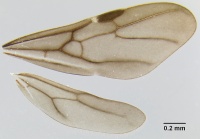Stenamma megamanni
| Stenamma megamanni | |
|---|---|

| |
| Scientific classification | |
| Kingdom: | Animalia |
| Phylum: | Arthropoda |
| Class: | Insecta |
| Order: | Hymenoptera |
| Family: | Formicidae |
| Subfamily: | Myrmicinae |
| Tribe: | Stenammini |
| Genus: | Stenamma |
| Species: | S. megamanni |
| Binomial name | |
| Stenamma megamanni Branstetter, 2013 | |
Stenamma megamanni occurs from 700–2800 m, but it is most common from 1400–2000 m (there is also one dubious record from 150 m at Pico Bonito). It mainly inhabits montane wet forest environments, such as cloud forest, oak-pine forest, riparian forest, and mesophyll forest. Specimens have been collected in samples of sifted leaf litter, by baiting, by use of a Malaise trap, and by searching. Nests are known from rotting logs, under rocks, in mud and clay banks, and in dead bark. Most collections of this species have been inside closed-canopy forest, but it has been found several times nesting in clearings near cloud forest (similar to Stenamma manni). The highest record of the species was a log nest in a clearing between lower elevation cloud forest and higher elevation pine forest. (Branstetter 2013)
Identification
Branstetter (2013) - Integument mostly black to red-black; medium- to large-sized species (see HL, ML, PrW below); lateral apex of hypostomal bridge projecting ventrally as a subquadrate to broadly rounded lobe, visible behind base of mandible in profile view; propodeal spines tuberculate (PSL 0.10–0.15, PSI 1.0–1.2); face and mesosoma usually completely sculptured with rugoreticulae and some carinulae (rarely with sculpture reduced); eye of moderate to large size (EL 0.14–0.19, REL 15–20), oval-shaped, with 8–11 ommatidia in greatest diameter; postpetiole usually appearing smaller than petiolar node (PPH/PH 0.85–0.98); basal margin of mandible straight to slightly sinuous; anterior clypeal margin with a median emargination.
As described above under Stenamma manni, separating S. megamanni from S. manni is difficult because of the great diversity in S. manni phenotypes across its range. At a local scale, however, separating S. megamanni from S. manni is usually easy. Stenamma megamanni is black and has a rather large eye with 8 or more ommatidia at greatest diameter. Stenamma manni in contrast is usually a dark red-brown color and has a smaller eye with 5–6 ommatidia at greatest diameter.
There is significant variation in sculpture, size and pilosity among populations. The type form appears rather robust with the promesonotum high-domed, and asymmetrical, and the sculpture very dense. The pronotal sculpture has very wavy, almost reticulate rugae. Most populations do not match the type population exactly. The closest is a collection at the locality 2km NE Macalajau in Guatemala, which was made at high elevation (2320 m) from a ground nest under a rock in a cloud forest clearing. This habit is quite different from that of the type population, which was found at lower elevation along a stream (see the biology section above). More commonly, workers appear somewhat less robust, with less dense sculpturing. A few populations have workers with very reduced face and promesonotal sculpture, and with more erect pilosity. One aberrant high-elevation collection from Guatemala (Pinalón) has very large workers, with transverse carinulae on the pronotum.
Keys including this Species
Distribution
Southern Mexico to Nicaragua.
Latitudinal Distribution Pattern
Latitudinal Range: 16.74687° to 12.925592°.
| North Temperate |
North Subtropical |
Tropical | South Subtropical |
South Temperate |
- Source: AntMaps
Distribution based on Regional Taxon Lists
Neotropical Region: Guatemala, Honduras, Mexico (type locality), Nicaragua.
Distribution based on AntMaps
Distribution based on AntWeb specimens
Check data from AntWeb
Countries Occupied
| Number of countries occupied by this species based on AntWiki Regional Taxon Lists. In general, fewer countries occupied indicates a narrower range, while more countries indicates a more widespread species. |

|
Estimated Abundance
| Relative abundance based on number of AntMaps records per species (this species within the purple bar). Fewer records (to the left) indicates a less abundant/encountered species while more records (to the right) indicates more abundant/encountered species. |

|
Biology
Branstetter (2013) - The type population was found nesting under rocks along a stream in mesophyll forest. This population was rather intriguing, because the nests were common and foragers were very abundant. In fact, S. megamanni workers were more common at cookie bait cards placed along the stream than the usually more dominant ant genus Pheidole. This phenomenon of becoming locally abundant and dominant seems a frequent characteristic of this species. At Cerro Kilambé in Nicaragua, for example, S. megamanni was nesting in clay banks bordering a small stream and was the dominant ant in the area.
Nests of this species are large for Stenamma, often containing several hundred workers. One nest at Cerro Kilambé, which was excavated from a mud bank, had 2-3 nest entrances and many chambers all filled with brood. The nest went about 10 cm into the bank, contained about 250 workers and had abundant larvae and pupae. Another nest from the same site was similar in size, but the chambers were constructed around small roots. All excavated nests have had single dealate queens.
Castes
Worker
Images from AntWeb
      
| |
| Worker. Specimen code casent0622851. Photographer Michael Branstetter, uploaded by Default Group. | |
 
| |
| Specimen code casent0622853. . | |
   
| |
| Worker. Specimen code casent0603933. Photographer Michael Branstetter, uploaded by Default Group. | Owned by MGBPC. |
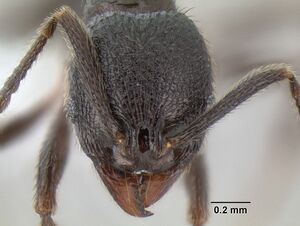   
| |
| Worker. Specimen code casent0606731. Photographer Michael Branstetter, uploaded by Default Group. | Owned by MGBPC. |
  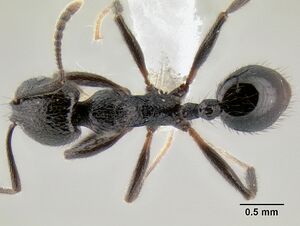 
| |
| Worker. Specimen code casent0606734. Photographer Michael Branstetter, uploaded by Default Group. | Owned by MGBPC. |
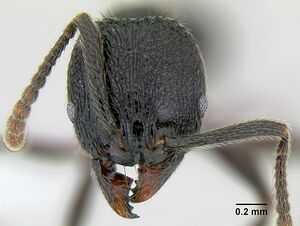  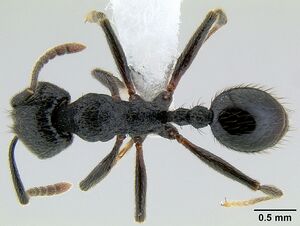 
| |
| Worker. Specimen code casent0621836. Photographer Michael Branstetter, uploaded by Default Group. | Owned by MGBPC. |
Queen
Images from AntWeb
    
| |
| Queen (alate/dealate). Specimen code casent0604840. Photographer Michael Branstetter, uploaded by Default Group. | Owned by MGBPC. |
    
| |
| Male (alate). Specimen code jtlc000007293. Photographer Michael Branstetter, uploaded by Default Group. | Owned by JTLC. |
Nomenclature
The following information is derived from Barry Bolton's Online Catalogue of the Ants of the World.
- megamanni. Stenamma megamanni Branstetter, 2013: 180, figs. 119-121 (w.q.m.) MEXICO (Chiapas), GUATEMALA, HONDURAS, NICARAGUA.
- Type-material: holotype worker, 16 paratype workers.
- Type-locality: holotype Mexico: Chiapas, Sierra Morena, 16.16121°N, 93.60024°W±50 m., 1320 m., 15.v.2008, MGB750 (M.G. Branstetter); paratypes: 15 workers with same data, 1 worker with same data but 16.16016°N, 93.60572°W±15m., 1360 m., 15.v.2008, LLAMA Ma-A-01-1-01.
- Type-depositories: USNM (holotype); CASC, CFSS, EAPZ, FMNH, ICNB, INBC, JTLC, LACM, MCZC, MGBC, MZSP, UCDC, UNAM, USNM, UVGC (paratypes).
- Distribution: Guatemala, Honduras, Mexico, Nicaragua.
Unless otherwise noted the text for the remainder of this section is reported from the publication that includes the original description.
Description
Worker
(12 measured) HL 0.93–1.15 (1.07), HW 0.80–1.08 (0.98), FLD 0.22–0.29 (0.25), PCW 0.05–0.10 (0.07), SL 0.79–0.98 (0.91), EL 0.14–0.19 (0.17), ACL 0.70–0.86 (0.78), ML 1.18–1.48 (1.36), PrW 0.53–0.69 (0.63), PSL 0.10–0.15 (0.12), SDL 0.09–0.14 (0.11), PL 0.40–0.54 (0.45), PH 0.25–0.32 (0.30), PW 0.18–0.25 (0.23), PPL 0.23–0.33 (0.26), PPH 0.21–0.31 (0.26), PPW 0.23–0.30 (0.28), MFL 0.97–1.23 (1.14), MTL 0.72–0.93 (0.85), CI 86–96 (91), SI 89–100 (93), REL 15–20 (18), FLI 25–28 (26), PSI 1.0–1.2 (1.1), MFI 82–90 (86), ACI1 61–63 (62), ACI2 84–89 (86).
Medium- to large-sized species; general body color black to red-black, with appendages black or dark brown to orange-brown, becoming lighter toward extremities at joints; setae dark golden brown to golden brown; mandible with 6 teeth, 2 teeth nearest basal tooth sometimes worn and indistinct; basal margin of mandible straight to slightly sinuous, without a basal depression or notch; mandible mostly smooth, with scattered piligerous punctae and a few striations near base and on lateral surface; anterior clypeal margin with a simple median emargination; median lobe of clypeus usually with a pair of longitudinal carinulae (type population), but sometimes surface smooth, or with several irregular carinulae, area in between carinulae often depressed; apex of lobe usually with a single transverse short carinula (type population), but sometimes with several transverse carinulae/rugulae; remainder of clypeus smooth and shiny; posterior extension of clypeus between antennal insertions of moderate width (PCW 0.05–0.10), sides subparallel; frontal lobes of moderate width (FLD 0.22–0.29; FLI 25–28) not greatly obscuring torular lobes in full-face view; lateral margin of hypostomal bridge with a projecting subquadrate lobe, visible in profile view (very rarely reduced and only visible from a lateroventral view); head roughly oval-shaped to more robust, becoming strongly heart-shaped (CI 86–96), posterior margin of head with a distinct median depression (especially in larger specimens); eye moderately large (EL 0.14–0.19, REL 15–20), oval-shaped, with 8–11 ommatidia at greatest diameter; face sculpture variable, usually strongly rugoreticulate, with some carinulae along midline (type population), but sometimes sculpture more polished, with area near posterior margin of head becoming somewhat smooth; scape of moderate length (SI 89–100), reaching posterior margin of head when laid back; scape usually thick and robust, surface carinate to carinulae with piligerous punctae; flagellum with a somewhat indistinct 4-segmented antennal club; mesosoma sculpture variable, often densely rugose, with rugae wavy, almost becoming reticulate (type population), but sculpture often reduced, with promesonotum longitudinally carinulate to nearly smooth, and side of propodeum and mesopleuron more punctate; promesonotum in profile domed, and usually asymmetrical (type population), with apex shifted anterior of midpoint, but sometimes promesonotum symmetrical; metanotal groove well-demarcated, sometimes somewhat wide and with metanotum forming a small welt (type population); propodeal spines tuberculate (PSL 0.10–0.15, PSI 1.0–1.2); petiole of moderate length, usually somewhat robust (PL/HW 0.45–0.52); petiolar node in profile of moderate height (PH/PL 0.59–0.68), dorsum usually broadly rounded and pointing vertically, only rarely forming a sharp apex; postpetiole in profile usually appearing smaller than petiolar node (PPH/PH 0.85–0.98); petiole and postpetiole usually strongly punctate, with a few rugulae on dorsum and anterior face of postpetiolar node (type population), sometimes anterior faces of petiolar and petiolar nodes mostly smooth; gaster mostly smooth, with scattered piligerous punctae; most of body dorsum with relatively long standing pilosity; pilosity on gastral dorsum sparse and mostly suberect (type population), usually with some shorter subdecumbent setae, suberect setae often somewhat stout; setae on promesonotum often noticeably erect; setae on scape uniformly suberect to decumbent; setae on legs mostly decumbent to appressed, with some suberect setae on femoral venters and coxae.
Queen
(5 measured) HL 1.01–1.12 (1.11), HW 0.92–1.03 (0.99), FLD 0.27–0.31 (0.31), PCW 0.07–0.10 (0.09), SL 0.87–0.97 (0.95), EL 0.26–0.28 (0.28), ACL 0.76–0.83 (0.83), ML 1.55–1.72 (1.71), PrW 0.93–1.04 (0.99), PSL 0.20–0.23 (0.20), SDL 0.15–0.17 (0.16), PL 0.57–0.60 (0.60), PH 0.33–0.39 (0.36), PW 0.26–0.31 (0.30), PPL 0.30–0.34 (0.34), PPH 0.32–0.39 (0.38), PPW 0.35–0.40 (0.38), MFL 1.13–1.26 (1.26), MTL 0.86–0.96 (0.93), CI 89–92 (89), SI 93–96 (96), REL 28–29 (28), FLI 28–31 (31), PSI 1.2–1.4 (1.2), MFI 78–84 (78), ACI1 60–62 (60), ACI2 83–89 (87).
Same as worker except for standard queen modifications and as follows: pronotum with transverse rugulae; mesoscutum longitudinally costulate; scutellum rugose to rugoreticulate; propodeum rugose to rugoreticulate; postpetiolar node larger, and somewhat anteroposteriorly compressed; mesopleuron mostly smooth; setae on mesoscutum short; setae on gastral dorsum often more dense, and more strongly bilayered, with layer of decumbent setae more dense; anterior quarter of gastral dorsum often with a layer of pubescence under stouter suberect and decumbent setae; wing venation as in photo.
Type Material
Holotype worker. MÉXICO, Chiapas: Sierra Morena, 16.16121°N, 93.60024 ±50m, 1320m, 15 May 2008, riparian mesophyll forest, nest under stone (M. G. Branstetter, collection MGB750) USNM, specimen CASENT0622851. Paratypes: same data as holotype 1w, CASC, CASENT0622852, 1w, EAPZ, CASENT0622853, 1w, ECOSCE, CASENT0622854, 1w, FMNH, CASENT0622855, 1w, ICN, CASENT0622856, 1w, INBio, CASENT0623361, 1w, JTLC, CASENT0623362, 1w, LACM, CASENT0623363, 1w, MGBPC, CASENT0623364, 1w, MCZ, CASENT0623365, 1w, MZSP, CASENT0623366, 1w, UCD, CASENT0623367, 1w, UNAM, CASENT0623368 , 1w, UVGC, CASENT0623369, 1w, USNM, CASENT0623370]; same data but 16.16016°N, 93.60572°W ±15m, 1360m, 15 May 2008 (LLAMA, Ma-A-01-1-01) 1dq, USNM, CASENT0604840.
Etymology
The specifici epithet megamanni was used to draw attention to the fact that this species looks like a larger, more robust version of Stenamma manni.
References
- Branstetter, M. G. 2012. Origin and diversification of the cryptic ant genus Stenamma Westwood (Hymenoptera: Formicidae), inferred from multilocus molecular data, biogeography and natural history. Systematic Entomology 37:478-496. doi:10.1111/j.1365-3113.2012.00624.x
- Branstetter, M.G. 2013. Revision of the Middle American clade of the ant genus Stenamma Westwood (Hymenoptera, Formicidae, Myrmicinae). ZooKeys 295, 1–277. doi:10.3897/zookeys.295.4905
References based on Global Ant Biodiversity Informatics
- Branstetter M.G. 2013. Revision of the Middle American clade of the ant genus Stenamma Westwood (Hymenoptera, Formicidae, Myrmicinae). ZooKeys 295: 1277
- Dattilo W. et al. 2019. MEXICO ANTS: incidence and abundance along the Nearctic-Neotropical interface. Ecology https://doi.org/10.1002/ecy.2944
- Longino J. T. L., and M. G. Branstetter. 2018. The truncated bell: an enigmatic but pervasive elevational diversity pattern in Middle American ants. Ecography 41: 1-12.


